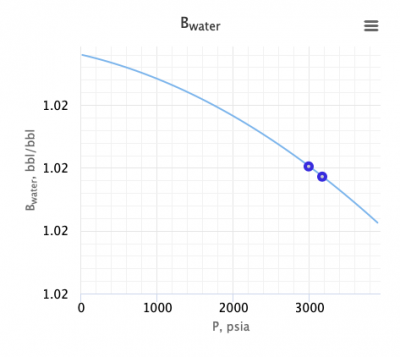Water formation volume factor
From wiki.pengtools.com
Contents
Water formation volume factor
The water formation volume factor represents the change in volume of the brine as it is transported from the reservoir conditions to surface conditions[1].
The units are reservoir barrels per surface barrel at standard conditions, res bbl/STB.
Math and Physics
where
Application range
The correlation is valid through the full range of solids concentrations, temperatures to 260F, and pressures to 5000psia[2].
Example. Calculating water formation volume factor
Example source [1]
Input data
Calculate water formation volume factor at 3176 psia and 165°F?
Solution
Nomenclature
 = water formation volume factor, res bbl/STB
= water formation volume factor, res bbl/STB = pressure, psia
= pressure, psia = Temperature, °F
= Temperature, °F = pressure correction, res bbl/STB
= pressure correction, res bbl/STB = temperature correction, res bbl/STB
= temperature correction, res bbl/STB
See also
- Water bubble point pressure
- Water compressibility
- Water density
- Water formation volume factor
- Water salinity from density equation
- Water solids concentration
- Water viscosity
References
- ↑ 1.0 1.1 1.2 McCain, W.D. Jr. (1990). Properties of Petroleum Fluids (2 ed.). Oklahoma: PennWell Corp. ISBN 978-0878143351.
- ↑ McCain, W.D. Jr. (1991). "Reservoir-Fluid Property Correlations-State of the Art"
 . Society of Petroleum Engineers (SPE-18571-PA).
. Society of Petroleum Engineers (SPE-18571-PA).







